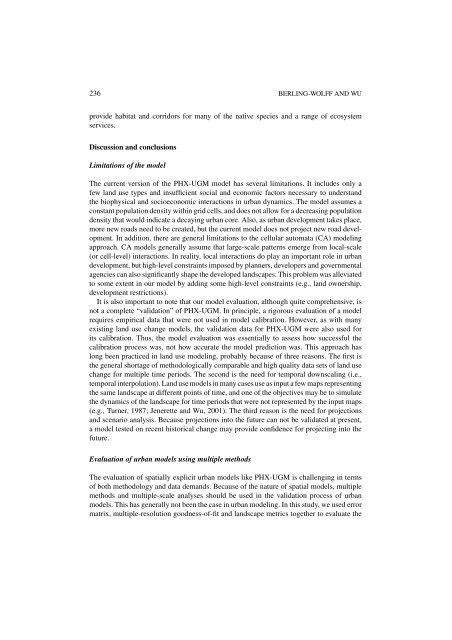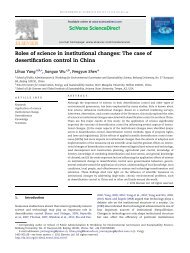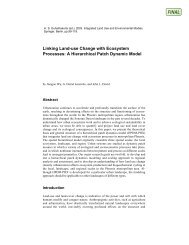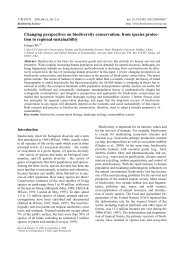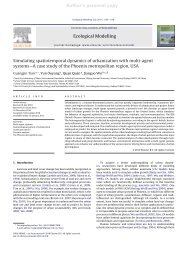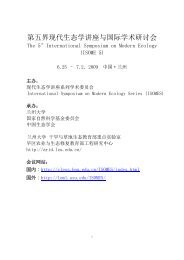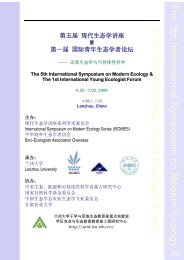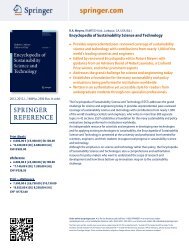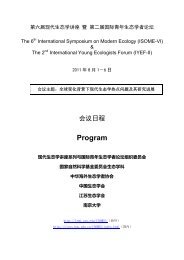Download PDF - Springer
Download PDF - Springer
Download PDF - Springer
Create successful ePaper yourself
Turn your PDF publications into a flip-book with our unique Google optimized e-Paper software.
236 BERLING-WOLFF AND WU<br />
provide habitat and corridors for many of the native species and a range of ecosystem<br />
services.<br />
Discussion and conclusions<br />
Limitations of the model<br />
The current version of the PHX-UGM model has several limitations. It includes only a<br />
few land use types and insufficient social and economic factors necessary to understand<br />
the biophysical and socioeconomic interactions in urban dynamics. The model assumes a<br />
constant population density within grid cells, and does not allow for a decreasing population<br />
density that would indicate a decaying urban core. Also, as urban development takes place,<br />
more new roads need to be created, but the current model does not project new road development.<br />
In addition, there are general limitations to the cellular automata (CA) modeling<br />
approach. CA models generally assume that large-scale patterns emerge from local-scale<br />
(or cell-level) interactions. In reality, local interactions do play an important role in urban<br />
development, but high-level constraints imposed by planners, developers and governmental<br />
agencies can also significantly shape the developed landscapes. This problem was alleviated<br />
to some extent in our model by adding some high-level constraints (e.g., land ownership,<br />
development restrictions).<br />
It is also important to note that our model evaluation, although quite comprehensive, is<br />
not a complete “validation” of PHX-UGM. In principle, a rigorous evaluation of a model<br />
requires empirical data that were not used in model calibration. However, as with many<br />
existing land use change models, the validation data for PHX-UGM were also used for<br />
its calibration. Thus, the model evaluation was essentially to assess how successful the<br />
calibration process was, not how accurate the model prediction was. This approach has<br />
long been practiced in land use modeling, probably because of three reasons. The first is<br />
the general shortage of methodologically comparable and high quality data sets of land use<br />
change for multiple time periods. The second is the need for temporal downscaling (i.e.,<br />
temporal interpolation). Land use models in many cases use as input a few maps representing<br />
the same landscape at different points of time, and one of the objectives may be to simulate<br />
the dynamics of the landscape for time periods that were not represented by the input maps<br />
(e.g., Turner, 1987; Jenerette and Wu, 2001). The third reason is the need for projections<br />
and scenario analysis. Because projections into the future can not be validated at present,<br />
a model tested on recent historical change may provide confidence for projecting into the<br />
future.<br />
Evaluation of urban models using multiple methods<br />
The evaluation of spatially explicit urban models like PHX-UGM is challenging in terms<br />
of both methodology and data demands. Because of the nature of spatial models, multiple<br />
methods and multiple-scale analyses should be used in the validation process of urban<br />
models. This has generally not been the case in urban modeling. In this study, we used error<br />
matrix, multiple-resolution goodness-of-fit and landscape metrics together to evaluate the


